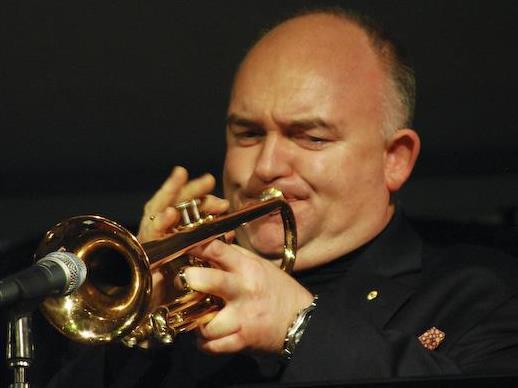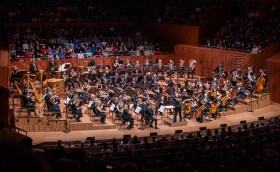James Morrison. Image supplied by Melbourne Symphony Orchestra.
Conductor Benjamin Northey did a great job of transforming the Melbourne Symphony Orchestra into a cracker of a big band on Saturday night, although most players apparently needed little persuasion. At least one looked as if he’d like to break ranks to join the jazz quartet and play with James Morrison, who was the focus of the concert.
As well as Morrison (famous for his trumpet-playing but in fact the musical embodiment of multi-skilling) other quartet members were Doug de Vries, guitar, Ben Robertson, bass guitar and drummer David Jones who delivered more than one memorable solo on the night. Huy-Nguyen Bui from the Australian and Ballet Orchestra was the concertmaster for the Melbourne Symphony Orchestra, and Hetty Kate both looked and sounded the part of jazz chanteuse from two different eras.
The program, accurately described as a journey through jazz, started with the 1920s and carried though into the 70s, by which time there were occasional forays into crossover or pop. Judging from appreciative ‘aaahs’, as well-known numbers started, and applause afterwards, the audience got what it hoped to hear, starting with Louis Armstrong’s ‘Basin Street Blues’. A couple of sensational trumpet riffs punctuated by strong chords from the orchestra set the pattern for the night, with Morrison’s humorous but informative patter illuminating the journey.
His early statement: ‘Jazz is a genre … but with many styles’ was borne out in contrasts like Whispering Jack Smith’s 1927 number ‘The Birth of the Blues’ (with Morrison delivering a mellow trombone, and de Vries accentuating the languorous tune) and the swing-inspired ‘Seven Come Eleven’, Benny Goodman’s piece of just seven years later.
Vocalist Hetty Kate, in dressy black and bling, lent her relaxed smooth voice to the often-recorded ‘Stardust’ and ‘Honeysuckle Rose’, the latter in particular delivered with a well-judged mix of clarity and breathiness. Morrison dominated the accompaniment with a trumpet solo that seemed to send Kate into a trance. She recovered enough however, to remark that this was the ultimate big band – and she didn’t think she could ever sing with anyone other than them again! (‘We’re working on it’, said Morrison. ‘Just trying to think how we’ll fit them all in the bus!’)
The mood of the night was one of enchantment spiced with humour, and toe-tapping enthusiasm. Morrison (playing a variety of instruments, including piano), Northey and all performers judged every piece well in terms of charming the audience. The big-band sound of ‘Don’t Get Around Much Anymore’ contrasted with the slow, measured beat of ‘Mood Indigo’.
A jump of nearly 30 years then brought us Count Basie’s ‘Li’l Darlin’’ (1958), with its snare drum and lovely piano improvisation. It led smoothly into ‘El Gato’, Duke Ellington’s Latin-inspired showpiece of the same year featuring trumpet, drum and more.
And that was just the first half!
With the early days of jazz from 1928 well articulated, Morrison chose to kick off the second half with ‘A Night in Tunisia’, his own trumpet solos doing justice to those of its creator, Dizzy Gillespie. Morrison put this and the next few works into the context of post-World War Two composition: less swing, smaller ensembles, the emergence of Bebop. The origins of modern jazz became recognisable in improvisation, the unexpected and harmonic complexity. Kate reappeared in a more modern, shorter, sparkling dress, delivering a long, smooth skat in response to Morrison’s busy trumpet solos.
This, and the Miles Davis standards, ‘All Blues’ and ‘‘Round Midnight’, were highlights of the second half, with the final three items taking a leap forward (in time) to the sixties and seventies, and the ‘jazz fusion’ Morrison identified. Perhaps the best part of these works was new paths for the orchestra to explore – and the MSO lost no opportunity to do so. If the musicians had proved their prowess as a big band, with Northey in command they left the audience in no doubt that they could play crossover and pop … and anything else they were asked to do!
But at the heart of this great program was James Morrison himself: multi-instrumentalist, raconteur with an encyclopaedic knowledge of jazz. Above all, one of the best jazz trumpeters you’re likely to hear in a lifetime.
Rating: 5 out of 5 stars
A Journey through Jazz: From Louis Armstrong to Herbie Hancock
James Morrison and the Melbourne Symphony Orchestra
Hamer Hall, St Kilda Rd
www.artscentremelbourne.com.au
8-9 March





